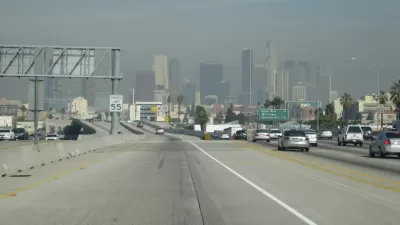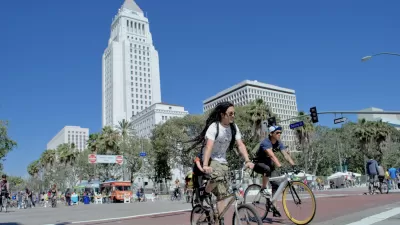The improvement in air quality comes from reductions in toxic emissions from autos, trucks, and ships. Enjoying the cleaner air were tens of thousands of Angelenos riding on miles of streets closed to auto traffic for the 10th CicLAvia event.
Risk of getting cancer from "exposure to 37 toxic pollutants—including diesel soot and arsenic," has been reduced by 65% according to a "study released by the South Coast Air Quality Management District on Oct. 2," reports Kristina Bravo of TakePart. By contrast, "(t)he last review reported a 17 percent drop between 1999 and 2005," she notes.
The greatest cancer risk from airborne emissions, 68.2 percent, comes from diesel particulate matter, as shown by Figure ES-3 in the report [PDF] and as explained by environmental reporter Tony Barboza of the Los Angeles Times.
Diesel exhaust remains the largest contributor to the problem, the air district's analysis found, and is responsible for more than two-thirds of all air pollution cancer risk in the region. About 90% of the risk comes from mobile sources, including cars, trucks, cargo ships, locomotives and airplanes.
Notwithstanding the pollutant reductions, Bravo reminds us that "compared with the rest of the nation, Southern California is still among the worst places to breathe."
However, Angelenos did breathe easier on Sunday, October 02, particularly those enjoying streets with no auto traffic thanks to the tenth CicLAvia event, which Bravo covers in a separate piece. She speaks with Jonathan Parfrey, "vice chair of the CicLAvia Board of Directors and the executive director of Climate Resolve, an organization that pushes for climate change action in the city."
FULL STORY: The Air in Southern California Just Got a Whole Lot Cleaner

Maui's Vacation Rental Debate Turns Ugly
Verbal attacks, misinformation campaigns and fistfights plague a high-stakes debate to convert thousands of vacation rentals into long-term housing.

Planetizen Federal Action Tracker
A weekly monitor of how Trump’s orders and actions are impacting planners and planning in America.

San Francisco Suspends Traffic Calming Amidst Record Deaths
Citing “a challenging fiscal landscape,” the city will cease the program on the heels of 42 traffic deaths, including 24 pedestrians.

Defunct Pittsburgh Power Plant to Become Residential Tower
A decommissioned steam heat plant will be redeveloped into almost 100 affordable housing units.

Trump Prompts Restructuring of Transportation Research Board in “Unprecedented Overreach”
The TRB has eliminated more than half of its committees including those focused on climate, equity, and cities.

Amtrak Rolls Out New Orleans to Alabama “Mardi Gras” Train
The new service will operate morning and evening departures between Mobile and New Orleans.
Urban Design for Planners 1: Software Tools
This six-course series explores essential urban design concepts using open source software and equips planners with the tools they need to participate fully in the urban design process.
Planning for Universal Design
Learn the tools for implementing Universal Design in planning regulations.
Heyer Gruel & Associates PA
JM Goldson LLC
Custer County Colorado
City of Camden Redevelopment Agency
City of Astoria
Transportation Research & Education Center (TREC) at Portland State University
Jefferson Parish Government
Camden Redevelopment Agency
City of Claremont




























